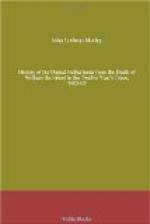Dorp refused to believe the intelligence. The squares were well guarded, the garrison ever alert. Spaniards were not birds of prey to fly up those perpendicular heights, and for beings without wings the thing was impossible. He followed Fleming through the darkness, and was soon convinced that the impossible was true. The precious squares were in the hands of the enemy. Nimble as monkeys, those yellow jerkined Italians, Walloons, and Spaniards—stormhats on their heads and swords in their teeth—had planted rope-ladders, swung themselves up the walls by hundreds upon hundreds, while the fight had been going on at the Porcupine, and were now rushing through the forts grinning defiance, yelling and chattering with fierce triumph, and beating down all opposition. It was splendidly done. The discomfited Dorp met small bodies of his men, panic-struck, reeling out from their stronghold, wounded, bleeding, shrieking for help and for orders. It seemed as if the Spaniards had dropped from the clouds. The Dutch commandant did his best to rally the fugitives, and to encourage those who had remained. All night long the furious battle raged, every inch of ground being contested; for both Catholics and Hollanders knew full well that this triumph was worth more than all that had been gained for the archduke in eighteen months of siege. Pike to pike, breast to breast, they fought through the dark April night; the last sobs of the hurricane dying unheard, the red lanterns flitting to and fro, the fireworks hissing in every direction of earth and air, the great wicker piles, heaped up with pitch and rosin, flaming over a scene more like a dance of goblins than a commonplace Christian massacre. At least fifteen hundred were killed— besiegers and besieged—during the storming of the forts and the determined but unsuccessful attempt of the Hollanders to retake them. And when at last the day had dawned, and the Spaniards could see the full extent of their victory, they set themselves with—unusual alacrity to killing such of the wounded and prisoners as were in their hands, while, at the same time, they turned the guns of their newly acquired works upon the main counterscarp of the town.




